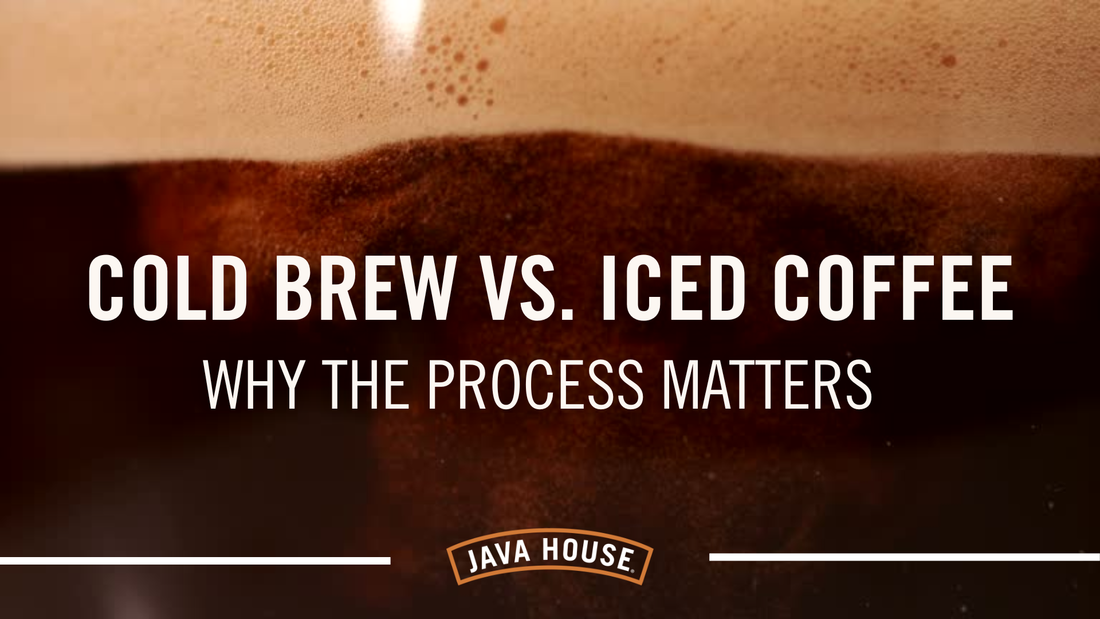
What’s the Difference Between Cold Brew and Iced Coffee?
Share
Cold Brew vs. Iced Coffee: It’s All About the Process
You might think cold brew and coffee are the same. Both can be served hot and cold, look similar, and give you that morning boost. But the truth is, the difference lies in the process. While iced coffee starts hot and ends cold, cold brew begins and stays cold the entire way, and that makes all the difference.
If you’ve ever wondered why cold brew tastes smoother and bolder, it’s because of the way it’s made. Instead of quick heat, cold brew relies on time, steeping coffee grounds slowly in cold water for 12 to 24 hours. The result is a naturally sweet, low-acid brew that’s versatile enough to enjoy cold over ice or heated up like your favorite hot coffee.
Understanding this difference matters not just for coffee lovers, but for anyone who wants better flavor, smoother energy, and more options in how they drink it. In this guide, we’ll break down how each brewing method works, why cold brew is changing how we think about coffee, and how Java House Cold Brew makes it easy to enjoy barista-quality flavor at home, hot or cold.
The Quick Answer

The main difference between cold brew and iced coffee is all in the brew method. Iced coffee is brewed hot, then cooled down and poured over ice. It’s quick, bright, and has that traditional coffee feel. Cold brew, on the other hand, never touches heat; it’s made by steeping coarse coffee grounds in cold water for 12–24 hours.
This slow process unlocks a smooth, balanced flavor that’s naturally sweet and low in acidity. Cold brew is more concentrated, which means you can drink it chilled, over ice, or even warmed up without losing its smoothness. For a no-prep option, Java House Cold Brew delivers perfectly steeped, ready-to-drink cold brew that you can enjoy your way, hot or cold with zero brewing time.
How Iced Coffee Is Made
Iced coffee starts hot. Coffee grounds are brewed with near-boiling water, which extracts flavors quickly and gives that recognizable boldness and acidity. After it’s brewed, it’s cooled down and poured over ice. The result is crisp and refreshing, but the quick brew time and heat can bring out sharper, sometimes bitter notes, especially once ice starts to melt and dilute the flavor.
Why the Process Matters
The brewing method is what defines the experience. Heat brings speed, but it also brings acidity. Time brings depth, and that’s where cold brew shines. The cold steeping process preserves natural coffee sugars and smooth chocolatey notes that often get lost in a hot brew.
So while iced coffee offers that quick, classic taste, cold brew gives you flexibility. One batch can last up to two weeks in your fridge and serve as your morning hot coffee, mid-day iced pick-me-up, or the base for creative drinks like cold brew lattes..
Java House Cold Brew: Smooth Flavor, Hot or Cold
What if you could skip the brewing and still enjoy the quality of a slow-steeped cold brew? With Java House Cold Brew, you can. Each box is filled with 100% Arabica coffee that’s steeped for 12–24 hours to lock in smooth, rich flavor.
No matter how you drink it, poured over ice, heated up for a cozy morning cup, or mixed into your favorite recipe, Java House Cold Brew gives you café-quality flavor with none of the bitterness or hassle. It’s cold brew made easy: no filters, no prep, just pour and enjoy.
☕ See Java House Cold Brew Products ←
The Bottom Line
Both iced coffee and cold brew have their place, but they’re made differently. Iced coffee starts hot and ends cold; cold brew starts cold and stays smooth no matter how you serve it.
If you love flexibility, low acidity, and rich, balanced flavor, you can enjoy hot or cold. Java House Cold Brew is your perfect match.
Want more ways to upgrade your coffee routine? Subscribe to our newsletter for brewing tips, recipes, and early access to exclusive flavors.
☕ Sign up today and get closer to your next smooth sip, straight from your fridge or your favorite mug.
